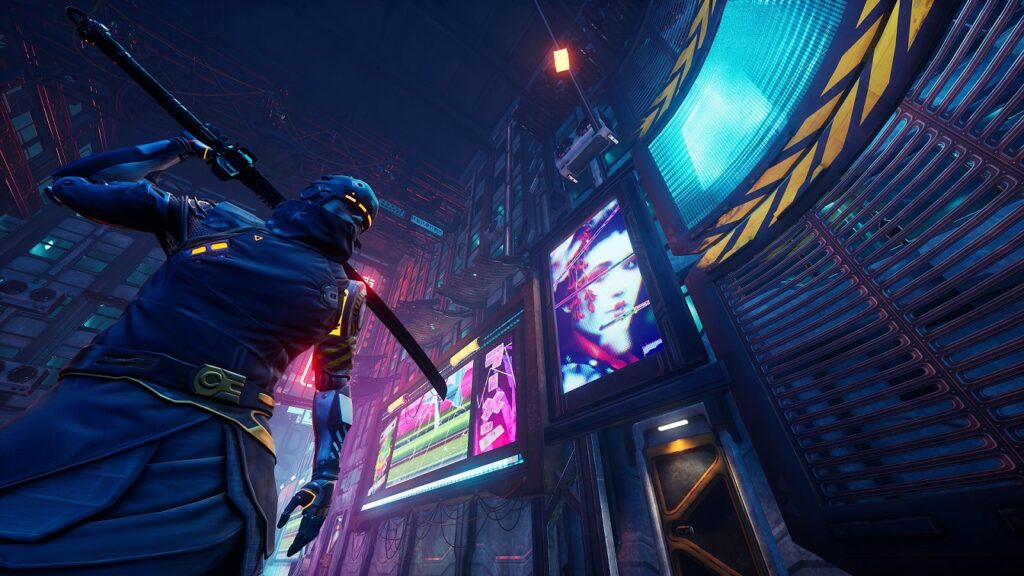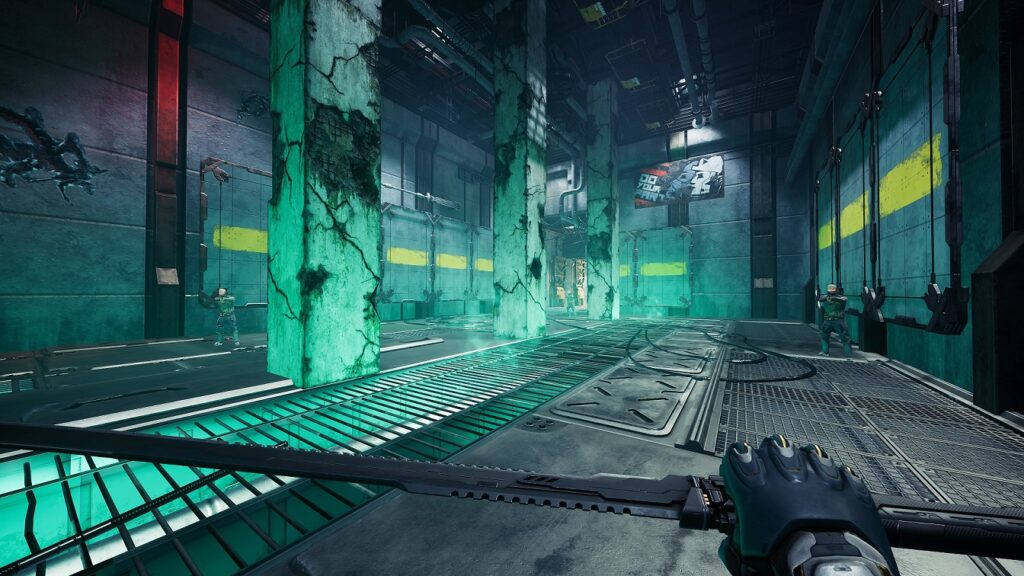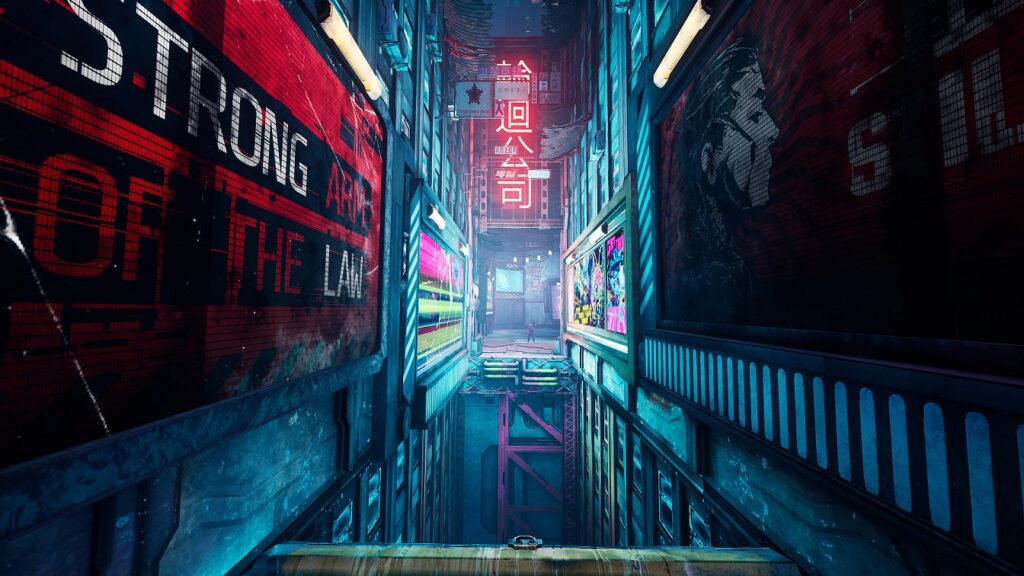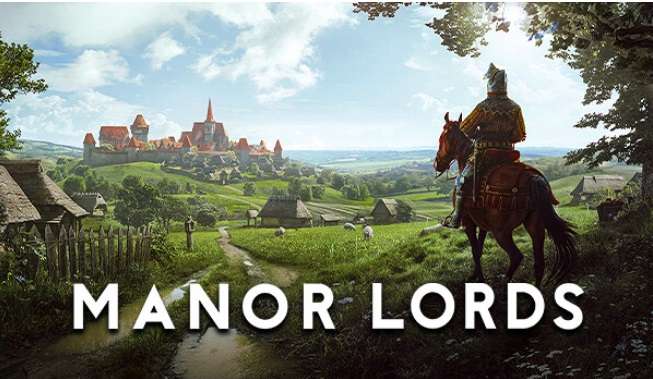I’m going to open this review by stating two objective truths about the universe: the cyberpunk genre is awesome and ninjas are awesome. Now, knowing these immutable facts of existence, it is only natural to ask the question: what would happen should one combine the two? Developers/puslishers One More Level, 3D Realms, Slipgate Ironworks, All in! Games, and 505 Games dared to ask that question, and Ghostrunner is the result. Ghostrunner: Complete Addition contains the base game, the Project_Hel DLC, and all cosmetic DLCs. Does Ghostrunner live up to its conceptually amazing premise? For the most part, yes.

You play as Jack: the titular Ghostrunner. After he finds himself at the base of Dharma City with a worrying case of amnesia, an A.I. known as the Architect guides him on a mission to kill Mara, the despotic ruler of Dharma City after she had killed every other Ghostrunner in a violent coup. The plot is serviceable. It gives you an objective and hints at interesting worldbuilding that are expanded upon in the collectibles. The characters aren’t the most standout of the bunch. In the main game, Jack and the Architect feel the most fleshed out with how much their dynamic shifts as the story progresses, from the Architect being a trustworthy guide through the world of Dharma City to the pair being at odds with each other over Jack’s growing moral conscious in spite of his nature as a machine. Unfortunately, the other characters aren’t as memorable.
For example, a character named Zoe joins your party early on and, despite adding some extra worldbuilding with her affiliation with a rebel group known as “The Climbers” and as a catalyst for some of Jack’s more heroic decisions, doesn’t leave much of an impact in terms of her personality or dynamic with the other protagonists. She’s abruptly written out of the plot at the start of the game’s third act and I didn’t even notice her absence until the epilogue where she abruptly shows up to give a speech about standing up to the man and changing the future. I honestly couldn’t tell you a thing about her personality besides she was a pretty generic “good guy”. The main antagonist is similarly bland. Mara is, to put it lightly, Doctor Octopus is he didn’t have the tragic backstory of the Raimi films/PS4 game to add pathos or the over-the-top personality of the comic/animated appearances. She’s a utilitarian mad scientist, and that would have been fine if her plan wasn’t pretty bad in execution (though, to avoid spoilers, I won’t touch on the specifics of it here).
As for the DLC levels, you play as Hel, a boss from the base game. In a prequel to the base game, Hel is tasked with wiping out the Climbers, but it more so acts to give her some much-needed characterization compared to the absolute nothing she got in the base game. While Hel isn’t a groundbreaking character, I found her sadistic tendencies and free-spirited attitude in opposition to Mara’s command oddly endearing, and she ended up becoming my favorite character.

But, I know full well that the story isn’t the main draw of Ghostrunner. Players will flock to this game for two things: the environment and the gameplay. So, how does this game present its world? In short: incredibly well. The many areas of Dharma City are well designed and well-rendered, giving each act of the game a distinct feel that’s fun to explore. The Base gives off an oppressive, industrial vibe that makes you feel the plight of the climbers more than words ever could. The City is the typical neon-lit Cyberpunk environment that you would expect from the genre, and it looks beautiful as the neon lights illuminate the dark skyline while players jump and dash from building to building. The top of the tower gives off an eerie, mad scientist feel to it that dips into horror in certain segments. The game also runs pretty well on the Playstation 5. I didn’t encounter many visual or auditory glitches during my playthrough of both the base game and the Project_Hel DLC. Also, the synthwave soundtrack both fits the cyberpunk setting perfectly and makes for some dang fine music on its own.
Which leads me to the main draw of Ghostrunner: its gameplay. Ghostrunner is a first-person-platformer mixed with action elements where everything, including you, dies in one hit. For mobility, both Jack and Hel can run, slide, dash both on the ground and in the air (if done in the air, time will slow down and you can adjust the angle with which you dash), and run on walls. As for specific abilities, Jack can utilize a grappling hook to reach certain areas while Hel has much more forward momentum with her basic jump and her air dash functions almost like a long-distance jump,allowing her to cover more distance than Jack ever could. Character movement in general is easy-to-pick-up and buttery smooth, which makes the act of mastering it all the more enticing as player’s journey to be the best cyber ninja badass they can possibly be.
Basic combat for both characters functions the same way. You have a sword. It kills things incredibly well. The nuance is found in the abilities of each character and the level design of encounters. Jack has four Cybervoid abilities at his disposal: a blink that slices through multiple enemies and projectiles, an air blast that blows away enemies, a long distance energy blast, and the ability to briefly mind control an enemy to attack other enemies. All abilities are useful in their own right, but the meter to use them is slow to refill which forces the player to consider which ability is the best to use for the situation. In contrast, Hel only has the surge ability, but it’s tied to a rage meter that quickly refills whenever an enemy is killed and runs out just as fast. In addition, if the rage meter is 50% full or more, the player can take an extra hit. This distinction creates a vast difference in how each character plays. With Jack, the player is encouraged to take a more tactical approach to encounters such as memorizing enemy placements, the routes to take them, and how best to take out certain enemies. With Hel, this strategic playstyle is still there, but the player is encouraged to adopt a more aggressive play style as they murder enemies en masse to keep up their rage meter (using their jumps and air dashes to better close distances) so that they can use the surge ability to wipe out even more enemies and raise hell (pun entirely intended).

This ties into how the game is designed overall. Each encounter has a few ways of completing them, and it’s up to the player to find out the best or else they get killed by a single mistake. However, this doesn’t feel like a total failure on the player’s part as respawning takes less than a second. Players can immediately get back into the action as soon as they die and are free to experiment. In a way, this makes the encounters of Ghostrunner feel less like your typical action game encounters and more like little murderous puzzle boxes that the players have to solve.
While I do think the overall gameplay is incredibly solid, I do have a few issues. Firstly, the boss fights are largely underwhelming. Going in, I was interested in how a game like Ghostrunner would handle boss fights. I thought I had my answer with T-073-M: a large laser-shooting, energy-wave-spewing cylinder that the Architect cheekily named “Tom”. Though I had initially thought that Tom was too difficult a boss to be considered “fun” or even “fair”, I had slowly shifted into learning the rhythm of the boss’s attacks, utilizing every skill I had learned from the game to achieve victory in a frenetic, mobility focused fight. Little did I know that the game’s boss fights peaked here. The second fight largely requires the player to stand still and parry until the boss is vulnerable, and the final fight against Mara takes place in a cramped arena where the player must avoid slow, predictable attacks until the boss is vulnerable. The fact that two out of the three bosses of the base game limit your mobility in a game that prioritizes mobility above everything else feels disappointing. I will say that the bosses of Project_Hel are much, much better in this regard. The DLC’s two bosses have you darting across the arena to avoid damage and it feels fun to play.
And then there are the Cybervoid segments. On occasion, the player will be forced to wander a digital void known as “Cybervoid” and solve puzzles to both progress and learn new abilities. They were intended to add variety to the gameplay, but instead grind the pacing to a screeching halt with puzzles that range from the simplistic and boring to the maddening (the rotating platforms still irk me even after completing them). This isn’t helped by the rather uninspired environment design of the Cybervoid as it looks like nearly every other cyberspace made entirely of cubes. And the less said about the final Cyberverse platforming encounter, the happier I will be.

Still, these flaws are miniscule compared to Ghostrunner’s triumphs. Ghostrunner is a smooth FPP that will make you feel like the unstoppable cyber-ninja of your dreams. Granted, Ghostrunner feels like the type of game that was made for a specific type of audience. That is to say, if you enjoy trying to break through insurmountable brick walls and, after breaking through, spending the rest of your time trying to break it faster and better, Ghostrunner is a must-play. If you don’t belong in that demographic, I still recommend the game. Despite Ghostrunner’s difficulty, its gameplay is an experience unlike any other.
I give Ghostrunner: Complete Edition an 8/10.
For more information about Ghostrunner, visit the official website.
Related: Reviews by Josh Freeman
I love games and love talking about games. Some of my favorites include action games (both 2D and 3D), metroidvanias, roguelikes, shooters, and Indies.





More Stories
Metro Simulator 2 Review for Xbox
GTA Online this Week Features New Community Series, Free Tees, Nightclub Bonuses, and More
MANOR LORDS Preview for Steam Early Access